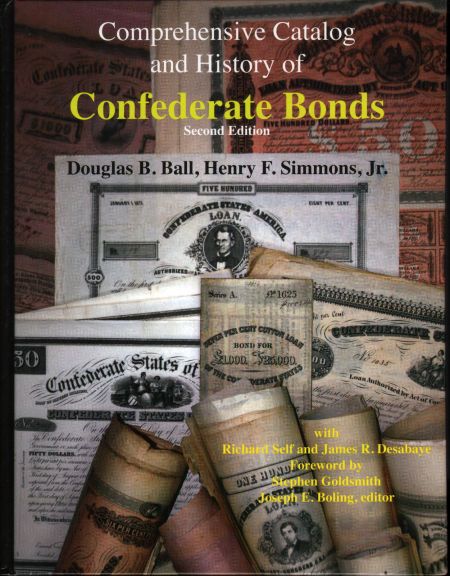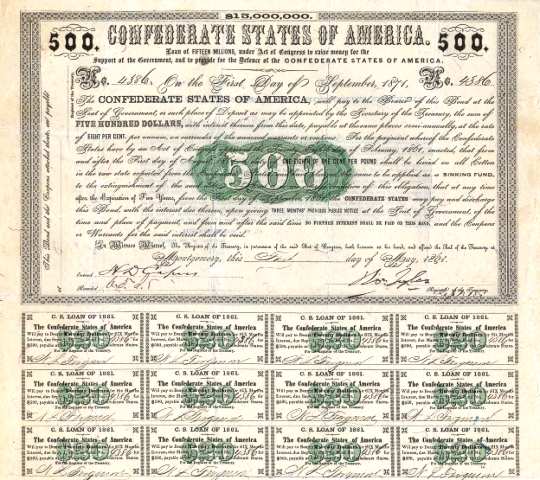Confederate Bonds
As with any war, the Confederate States of America (CSA) needed to raise money to finance their huge war effort. The two primary ways to do this was by taxes and debt. Confederate Secretary of the Treasury Christopher G. Memminger assumed his duties in February 1861 by floating government loans and creating an instant national debt. In 1861 the Confederacy sold bonds worth $150 million in the so-called Bankers Loan, which secured much-needed specie. The government also tapped agricultural staples through the Produce Loan, in which planters pledged their produce in exchange for government paper. Against the receipts of these loans, Memminger issued Treasury notes, circulating paper money with which the government paid its bills. In August, 1861 the Confederate Congress passed a War Tax on various kinds of property to increase government resources. Unfortunately Memminger’s department was inefficient in collecting the produce subscribed to the Produce Loan, and he allowed taxes to be paid in inflated state currency. Consequently, government paper money fed inflation, which served as an inverse tax on Confederate citizens.
|
|
Civil War Timeline
-
December 20,1861 – South Carolina secedes from the Union.
-
February, 1861 – A constitutional convention prepares a provisional constitution and chooses members of a provisional government.
-
March 11, 1861 – A permanent constitution is ratified.
-
February 18, 1862 – A permanent legislature is established.
-
January 5,1863 – Jefferson Davis reacts to Emancipation Proclamation with speech calling for free blacks to be reenslaved
-
March 13, 1865 – Faced with severe manpower shortages the CSA reluctantly agreed to use African American troops.
-
March 18, 1865 – The Congress of the CSA adjourned for the last time.
-
April 2, 1865 ->Jefferson Davis and most of his Cabinet flee the Confederate capital of Richmond.
-
April 3, 1865 – Union forces capture the capital Richmond, Virginia.
-
April 9, 1865 – Confederate General Robert E. Lee surrenders to Union General Ulysses S. Grant, thereby effectively putting an end to the Confederacy.
As with any war, the Confederate States of America (CSA) needed to raise money to finance their huge war effort. The two primary ways to do this was by taxes and debt. Confederate Secretary of the Treasury Christopher G. Memminger assumed his duties in February 1861 by floating government loans and creating an instant national debt. In 1861 the Confederacy sold bonds worth $150 million in the so-called Bankers Loan, which secured much-needed specie. The government also tapped agricultural staples through the Produce Loan, in which planters pledged their produce in exchange for government paper. Against the receipts of these loans, Memminger issued Treasury notes, circulating paper money with which the government paid its bills. In August, 1861 the Confederate Congress passed a War Tax on various kinds of property to increase government resources. Unfortunately Memminger’s department was inefficient in collecting the produce subscribed to the Produce Loan, and he allowed taxes to be paid in inflated state currency. Consequently government paper money fed inflation, which served as an inverse tax on Confederate citizens.
By 1863 Memminger realized that inflation was threatening the government’s ability to support itself and the war. Accordingly he proposed and Congress passed a graduated Income Tax and a 10% Tax In Kind on agricultural products. In March, 1863 the Confederacy accepted a $15 million loan from the French banking house of Emile Erlanger that yielded much less than its face value (about $8.5 million), but given the tenuous nature of Southern nationhood, the Confederates made the best deal possible. Still, Memminger’s printing presses moved faster than the government could collect revenue, and inflation accelerated. In desperation, in 1864 Memminger imposed a Compulsory Funding Measure, which devalued those Treasury notes not exchanged for non circulating government bonds. This failed too, as Confederates continued to exchange government paper for goods and services.
In July 1864 Jefferson Davis replaced Memminger with another South Carolinian, George A. Trenholm, but there was little Trenholm could do. The Confederacy never had more than $27 million of specie. The national debt ran over $700 million and the overall inflation was about 6,000%. That the Confederacy persisted as long as it did amid this financial chaos was a wonder. History from Historical Times History of the Civil War
|
|






